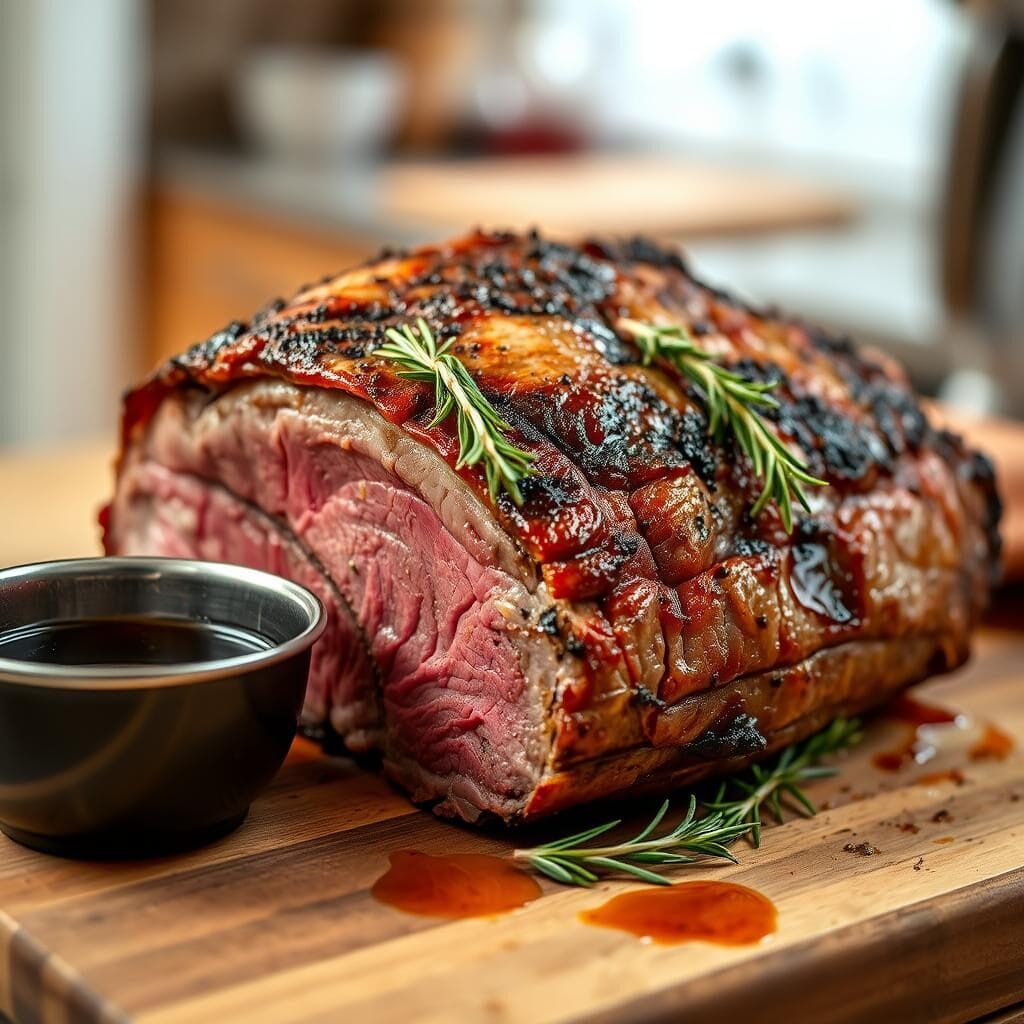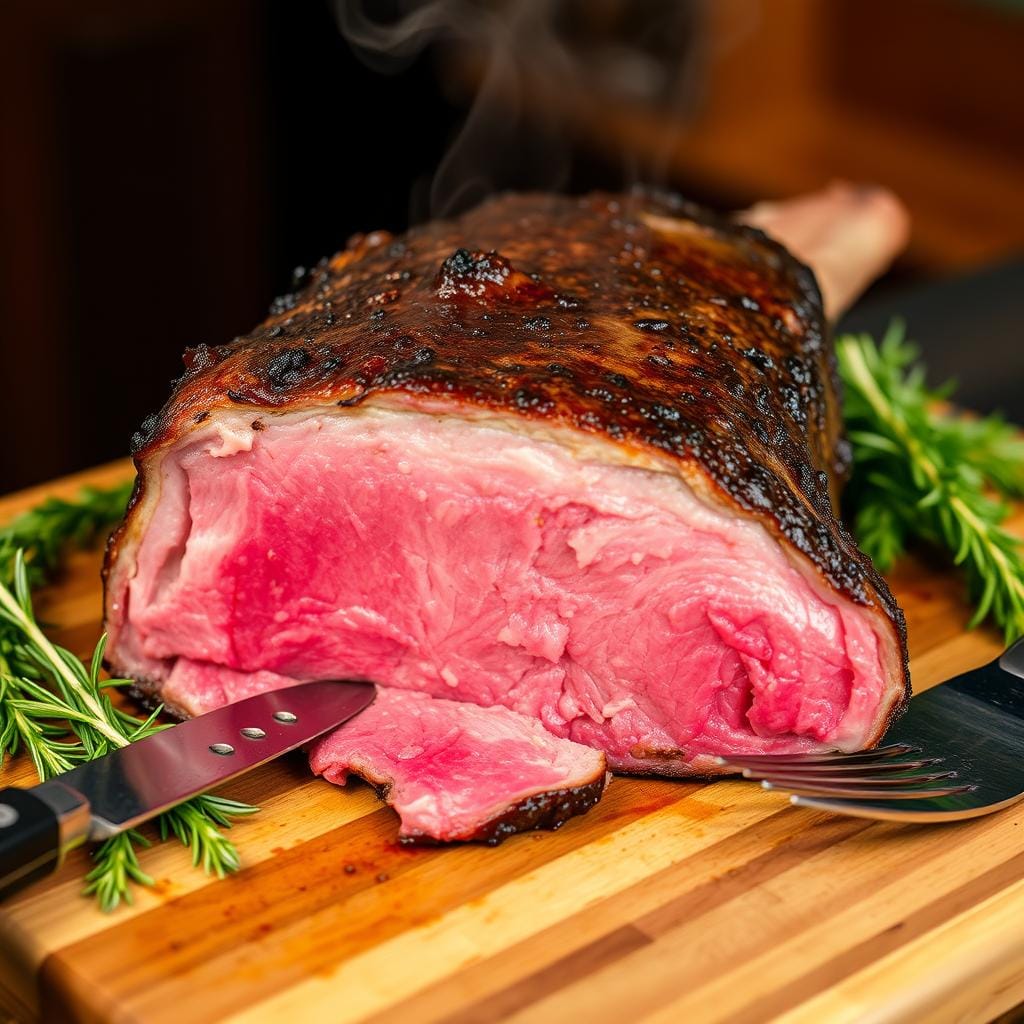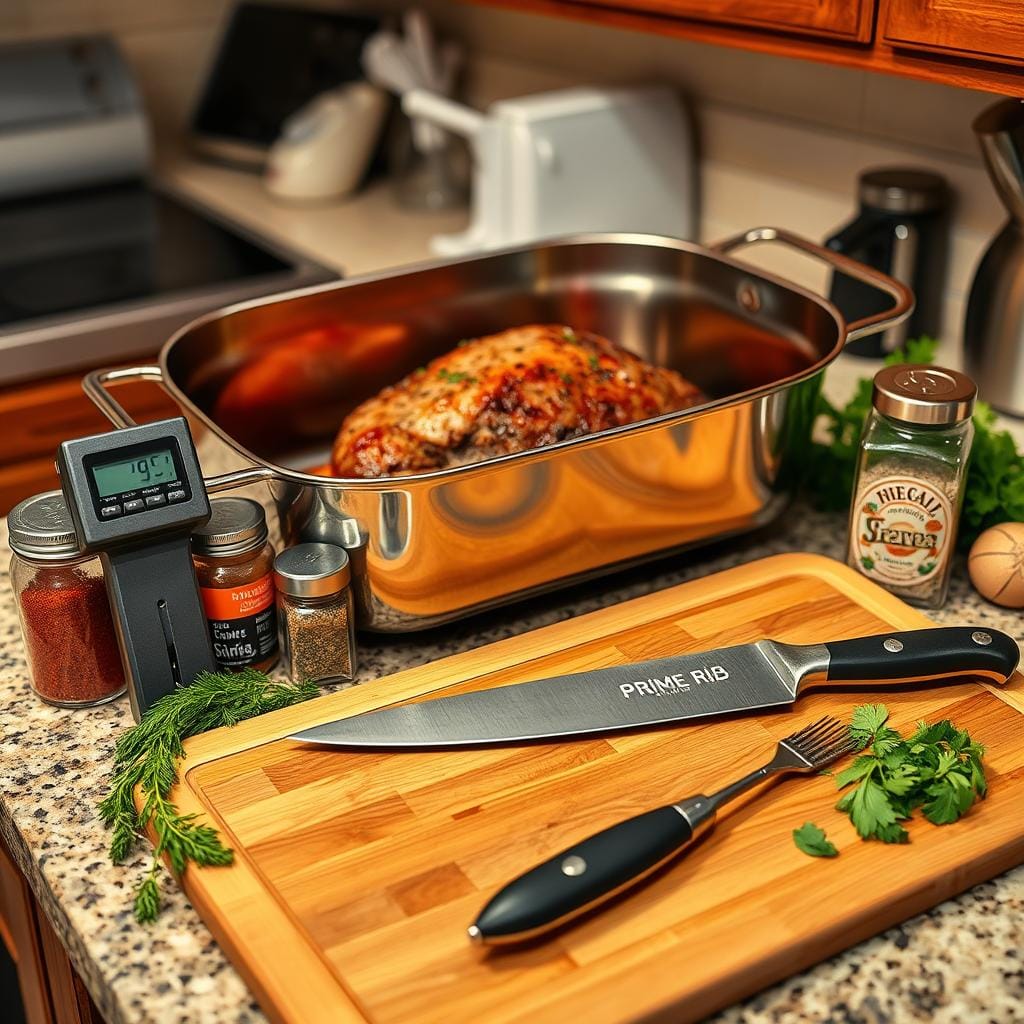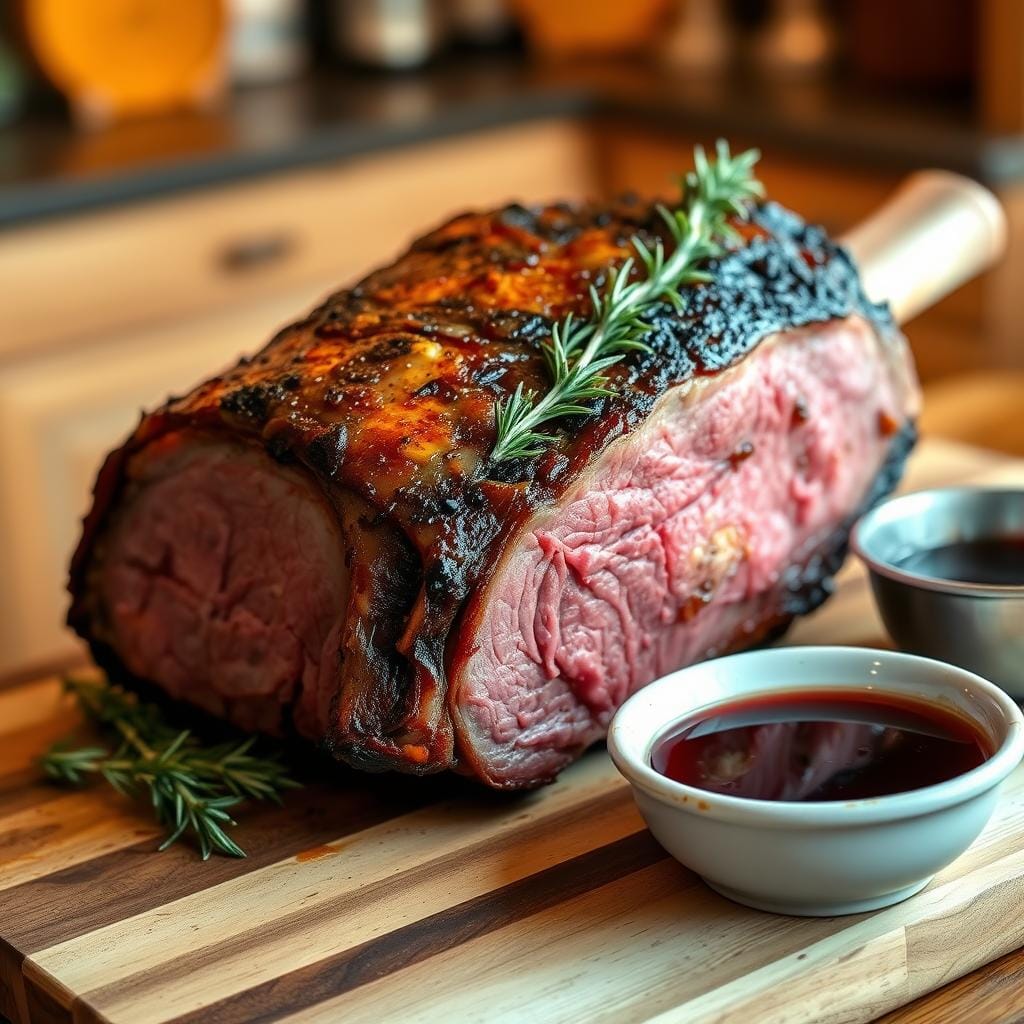I love cooking at home, especially prime rib. It’s tender and full of flavor. It makes any meal special. Learning to cook prime rib well is a skill worth having.
In this guide, I’ll share tips to make you a prime rib expert. You’ll learn about the cut, cooking methods, and how to avoid mistakes. This will help you make prime rib like a pro at home. Whether you’re new to cooking or experienced, let’s explore prime rib together.

Key Takeaways
- Discover the essential differences between prime rib cuts and USDA grades to make an informed selection.
- Explore three primary cooking methods – traditional roasting, reverse searing, and sous vide – and learn the pros and cons of each.
- Master the art of seasoning prime rib with the perfect blend of dry rubs, herbs, marinades, and butter-garlic combinations.
- Understand the importance of temperature control and resting periods to achieve your desired level of doneness.
- Learn professional-level carving techniques to present your prime rib with restaurant-worthy flair.
Understanding Prime Rib: A Premium Cut of Beef
Prime rib is a luxurious cut of beef known for its rich flavor and tender texture. To fully enjoy this premium roast, it’s important to know its unique anatomy and what makes it so special.
Anatomy of Prime Rib
Prime rib, also known as a standing rib roast, comes from the rib primal. It spans from ribs six through twelve. This area is between the loin and the chuck. It’s famous for its marbling, which is fat within the muscle.
This marbling is what makes prime rib so juicy and tender. It adds a rich, succulent taste to the meat.
USDA Grades and Selection
When picking prime rib, the USDA grading system is key. The USDA grades beef by marbling, with prime rib being the top grade. Prime rib is the priciest but offers a unique dining experience.
Bone-in vs. Boneless Comparison
- Bone-in prime rib: Keeps more natural flavor and juices, but carving can be tricky.
- Boneless prime rib: Easier to slice and serve, but might lose some flavor and tenderness.
The choice between bone-in and boneless prime rib depends on your taste and presentation. Both can make for a delicious meal when cooked right.

Essential Equipment for Perfect Prime Rib Preparation
Cooking the perfect prime rib needs the right tools and equipment. From the prime rib cooking equipment to the essential roasting pan and meat thermometer, having the proper gear is key. It makes all the difference in achieving your desired results.
To begin, you’ll need a high-quality roasting pan that fits your prime rib. Choose a pan with sturdy construction and a tight-fitting lid. This ensures even cooking and keeps moisture in. Also, a meat thermometer is crucial. It helps you check the prime rib’s internal temperature and ensure it’s cooked just right.
Other essential equipment for prime rib preparation includes:
- Sharp carving knife and fork for clean, precise slicing
- Basting brush to apply seasoning and juices during cooking
- Aluminum foil or parchment paper for resting the meat
- Cutting board with a well to catch any drippings
| Equipment | Importance |
|---|---|
| Roasting Pan | Ensures even cooking and minimal moisture loss |
| Meat Thermometer | Helps monitor the internal temperature for perfect doneness |
| Carving Knife and Fork | Allows for clean, precise slicing of the prime rib |

Remember, having the right prime rib cooking equipment is crucial for achieving the best results. Invest in high-quality tools. This will help you create a perfectly cooked and beautifully presented prime rib every time.
Which is the best way to cook prime rib?
There are many ways to cook a perfect prime rib. Each method has its own benefits. The best choice depends on what you like, your cooking skills, and what you want to achieve. Let’s look at three popular methods: traditional roasting, reverse searing, and sous vide.
Traditional Roasting Method
The classic roasting method is well-loved. It involves searing the prime rib first and then cooking it slowly in the oven. This method is easy and often results in delicious meat. But, you need to watch it closely to avoid overcooking.
Reverse Searing Technique
The reverse searing method is different. It cooks the prime rib slowly in the oven until it’s just right, then sears it quickly. This way, the meat stays juicy and evenly cooked. It takes more time and planning, though.
Sous Vide Approach
The sous vide method cooks the prime rib in a water bath at a precise temperature. This ensures the meat is perfectly cooked all the way through. It requires special equipment but can make the meat incredibly tender and flavorful.
Choosing the best way to cook prime rib depends on your preferences, skills, and available equipment. Try out these prime rib cooking methods to find the best way to cook prime rib for you.
Prime Rib Temperature Guide for Every Doneness Level
Getting the perfect doneness in your prime rib is key for a great meal. Whether you like it rare, medium-rare, medium, or well-done, knowing the right temperatures is essential. This guide will help you achieve the perfect texture and flavor for every doneness level.
| Doneness Level | Internal Temperature Range | Appearance and Texture |
|---|---|---|
| Rare | 120°F to 125°F | Bright red center, cool to the touch, and very soft and tender. |
| Medium-Rare | 130°F to 135°F | Warm, red center with a warm, pinkish-red outer layer. The texture is soft and juicy. |
| Medium | 140°F to 145°F | Warm, pink center with a slightly firmer texture. The outer layer is a light brown color. |
| Medium-Well | 150°F to 155°F | Slightly pink center with a more uniform, brown-gray color throughout. The texture is firm but still tender. |
| Well-Done | 160°F and above | Fully cooked throughout, with a uniform brown color and a firm, dry texture. |
Remember, the prime rib temperature will rise a bit after you take it out of the oven or grill. So, aim to remove it when it’s a few degrees shy of your desired prime rib doneness. Using a meat thermometer is vital for getting your prime rib just right every time.
Mastering Prime Rib Seasoning Techniques
To make your prime rib taste amazing, you need more than just the right cooking method. Learning how to season it is key to a delicious prime rib. You can try dry rubs or marinades to add flavor to your beef.
Dry Rubs and Herbs
A good prime rib dry rub can make your prime rib’s surface taste great. Mix herbs and spices like garlic powder, black pepper, and rosemary. Rub this mix all over the prime rib to get the best flavor.
Marinade Options
For a richer taste, marinate your prime rib in a prime rib marinade. Mix olive oil, soy sauce, and Dijon mustard with herbs and spices. Let it marinate for hours or overnight for a flavorful dish.
Garlic and Butter Combinations
Garlic and butter are a classic combo for prime rib seasoning. Mix minced garlic with softened butter. Rub this butter on the prime rib. As it roasts, the butter will melt and add a delicious flavor.
“The secret to a truly exceptional prime rib lies in the seasoning. With the right blend of flavors, you can transform a good cut of beef into a culinary masterpiece.”
Step-by-Step Preparation Process
Preparing the perfect prime rib is an art that needs careful attention. Whether you’re a seasoned chef or a home cook, a step-by-step process is key. This ensures your prime rib turns out delicious.
Start by trimming and tying your prime rib. Remove excess fat and silver skin, leaving a thin layer for basting. Then, use kitchen twine to tie the roast at regular intervals. This helps it cook evenly.
- Trim the prime rib, removing excess fat and silver skin.
- Tie the roast at regular intervals using kitchen twine.
Next, season your prime rib. Try different dry rubs, herbs, and spices to find your favorite flavor. Rub the seasoning all over the meat, making sure to cover every part.
- Experiment with dry rubs, herbs, and spices to season the prime rib.
- Rub the seasoning evenly over the entire surface of the meat.
Finally, let your seasoned prime rib rest at room temperature for at least 30 minutes before cooking. This step helps the meat relax and the flavors to meld. It ensures a juicy and flavorful result.
By following these simple steps, you’ll be well on your way to preparing a prime rib that will impress your guests. Remember, the key to success is in the details and following the process. Bon appétit!
Optimal Cooking Times and Temperature Control
Mastering the perfect prime rib is all about controlling cooking times and temperatures. You can choose from roasting, reverse-searing, or sous vide. Knowing the right times and temperatures is key to delicious results.
Time Per Pound Guidelines
The basic rule for prime rib cooking time is 15-20 minutes per pound for rare. For medium-rare, it’s 20-25 minutes per pound. And for medium, it’s 25-30 minutes per pound. But, these times can change based on oven temperature, cut thickness, and your doneness preference.
Temperature Monitoring Tips
- Use a reliable meat thermometer to monitor the internal temperature of the prime rib throughout the cooking process.
- For the traditional roasting method, aim to remove the prime rib from the oven when the internal temperature is 5°F below your target doneness temperature, as the temperature will continue to rise during the resting period.
- When reverse-searing, monitor the temperature carefully to ensure the meat reaches the desired doneness before the final sear.
- For the sous vide approach, maintain a consistent water temperature throughout the cooking time to achieve precise and even results.
By mastering cooking times and temperature control, you can make prime rib that’s tender, juicy, and full of flavor every time.
The Art of Resting Your Prime Rib
Resting your prime rib is key to getting the perfect texture and flavor. After choosing, seasoning, and cooking your prime rib, it’s important to let it rest before carving. This step helps the juices spread evenly, making your prime rib tender and juicy.
The best prime rib resting time is 15 to 30 minutes. This lets the meat’s temperature rise a bit and the juices get back into the meat. But, resting it too long can make it cooler and less tasty.
To get the how long to rest prime rib just right, just follow these steps:
- Take the prime rib out of the oven or heat and put it on a cutting board or platter.
- Loosely cover the prime rib with aluminum foil to keep the heat in and let the juices spread.
- Let it rest for 15 to 30 minutes, depending on its size. A bigger prime rib might need up to 30 minutes.
- Keep an eye on the prime rib’s temperature while it’s resting. It will keep rising.
By following these tips, your prime rib will be perfectly cooked, juicy, and ready to serve to your guests.
“The secret to a great prime rib is all in the resting. Take the time to let the juices redistribute, and you’ll be rewarded with a truly exceptional dining experience.”
Carving Techniques for Restaurant-Quality Presentation
Carving a prime rib roast with precision is key to a stunning presentation. Mastering the right techniques and using the proper tools can transform a prime rib into a centerpiece that impresses guests.
Required Tools
To carve your prime rib like a pro, you’ll need a few essential tools:
- A sharp carving knife with a long, flexible blade
- A cutting board that’s large enough to accommodate the entire roast
- A carving fork to hold the meat in place while slicing
- A meat thermometer to ensure your prime rib is cooked to perfection
Professional Cutting Methods
Follow these step-by-step instructions to carve your prime rib roast like a seasoned chef:
- Allow the roast to rest for at least 15-20 minutes after cooking, allowing the juices to redistribute throughout the meat.
- Position the roast with the bones facing you, and use your carving fork to hold the meat in place.
- Starting at the narrow end of the roast, slice the meat across the grain, making thin, even slices about 1/2-inch thick.
- As you work your way down the roast, be sure to adjust the carving fork to keep the meat stable and prevent it from falling apart.
- Arrange the sliced prime rib on a serving platter, ensuring each slice is evenly sized and presented beautifully.
By following these prime rib carving techniques, you’ll be able to achieve a restaurant-quality presentation. This showcases the tender, juicy perfection of your expertly cooked prime rib.
Common Prime Rib Cooking Mistakes to Avoid
Getting the perfect prime rib can be tough, but knowing common mistakes helps. Issues like overcooking and bad seasoning can mess up an otherwise great cut of beef.
One big problem is overcooking the prime rib. This makes it dry, tough, and loses its juicy tenderness. To fix this, keep an eye on the internal temperature and take it out of the oven when it’s just right.
Not seasoning the prime rib well is another mistake. This can make the dish taste bland. Make sure to season it evenly with a tasty dry rub or marinade. This lets the flavors soak into the meat.
- Overcooking the prime rib
- Inadequate seasoning or dry rub application
- Insufficient resting time before carving
- Cutting the prime rib incorrectly
- Failing to monitor the internal temperature
Not letting the prime rib rest before carving is another mistake. This step helps the juices spread, making the meat tender and juicy. Cutting into it too soon can lose those juices.
By avoiding these mistakes, you can make a prime rib that’s as good as a restaurant’s. Your guests will be impressed.
Serving Suggestions and Accompaniments
Serving prime rib with the right side dishes and wine can make your meal special. There are many ways to enhance the flavor of this premium beef. From classic dishes to new ideas, you can find the perfect match.
Traditional Side Dishes
Classic side dishes are a must for prime rib. Here are some favorites:
- Yorkshire pudding: This savory dish is a traditional favorite, capturing the essence of prime rib.
- Roasted vegetables: Carrots, potatoes, onions, and more, roasted to perfection, make a great side.
- Creamy mashed potatoes: A comforting side that absorbs the au jus or horseradish sauce.
- Sautéed mushrooms: Earthy mushrooms add a touch of umami to the dish.
Wine Pairing Recommendations
Choosing the right wine for prime rib can make the meal even better. Here are some top picks:
- Full-bodied red wines, like Cabernet Sauvignon or Merlot, complement the prime rib’s rich flavors.
- Robust Bordeaux-style blends stand up to the bold taste of prime rib.
- Smooth and silky Pinot Noir offers a delicate balance that pairs well with the tender meat.
Quality ingredients and traditional cooking methods are key to a great prime rib experience. The right side dishes and wine make your prime rib the main attraction.
Conclusion
Cooking the perfect prime rib is an art that needs precision, patience, and knowledge. You’ve learned how to choose the best USDA grade and master different cooking methods. Now, you have the key to improve your prime rib cooking.
There are many ways to cook prime rib, like roasting, reverse searing, or sous vide. The most important thing is to try different methods and find what works best for you. Don’t forget to experiment with seasonings, marinades, and flavors to make your prime rib unique. Always check the internal temperature and let it rest for the best taste and texture.
With the tips from this article, you’ll soon be making prime rib like a pro at home. Serve it with classic sides and a wine pairing for a memorable meal. Enjoy the art of cooking prime rib and show off your skills.

